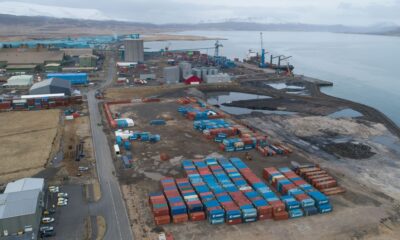Business
Ford beats on earnings but lowers 2025 guidance after supplier fire

A Ford logo on a Ford F-150 pickup truck for sale in Encinitas, California, U.S. Oct. 20, 2025.
Mike Blake | Reuters
DETROIT – Ford Motor beat Wall Street’s third-quarter earnings expectations but lowered its 2025 guidance due to impacts of a supplier fire, which is disrupting production of its highly profitable large trucks and SUVs.
The Detroit automaker said the fire last month at a New York plant for aluminum supplier Novelis is expected to cost it between $1.5 billion and $2 billion, but it expects to mitigate much of that this year and next, largely by increasing manufacturing of the impacted vehicles once supplies are more available.
Ford stock initially fell during extended trading Thursday before swinging to being up roughly 4%. It closed at $12.34 per share Thursday and the stock is up 24% so far this year.
Ford said the total cost of the fire on its business is expected to be less than $1 billion by next year, as the company announced plans Thursday to “significantly increase” its U.S. pickup truck production. That includes adding 1,000 workers early next year to plants that produce the vehicles in Michigan and Kentucky.
The automaker expects the additional production next year to recoup about half of the 100,000 units it expects to lose due to the fire this year.
“We are working intensively with Novelis and others to source aluminum that can be processed in the cold rolling section of the plant that remains operational while also working to restore overall plant production. We have made substantial progress in a short time to minimize the impact in 2025 and recover production in 2026,” Ford CEO Jim Farley said in a statement.
Ford stock
Ford Chief Operating Officer Kumar Galhotra said the fire occurred in one of three main parts of the plant — a hot mill — with the non-impacted areas continuing to operate. The impacted part of the plant is expected to restart sooner than originally expected in late November or early December, he said.
Ford’s new 2025 guidance includes adjusted earnings before interest and taxes of $6 billion to $6.5 billion, down from $6.5 billion to $7.5 billion as of July; adjusted free cash flow of $2 billion to $3 billion, down from $3.5 billion to $4.5 billion, and capital spending of roughly $9 billion, which remains the same.
Ford CFO Sherry House said without the supplier fire, the company was planning to raise its 2025 guidance to more than $8 billion in adjusted EBIT rather than cutting it.
RBC Markets analyst Tom Narayan in a note Thursday called the guidance change “effectively” a raise, backing out the supplier fire and changes in tariff costs.
Ford lowered its expected tariff costs by $1 billion, to roughly $2 billion, half of which the automaker expects to offset through other actions, due to changes Friday by the Trump administration that included exemption and extending tariff offsets on American-made vehicles.
Here’s what Wall Street expects, based on average analysts’ estimates compiled by LSEG:
- Earnings per share: 45 cents adjusted vs. 36 cents expected
- Automotive revenue: $47.19 billion vs. $43.08 billion expected
Ford said there was no material impact to third-quarter results due to the fire, but that it will impact its fourth-quarter results.
The company’s third-quarter revenue, including its financial arm, was $50.5 billion, a quarterly record and 9% increase from the same time a year ago. Its net income during the quarter was $2.4 billion, up from $900 million a year earlier, and adjusted earnings before interest and taxes were level at $2.6 billion. Both included adverse net tariff-related impact of $700 million during the third quarter.
Adjusted earnings exclude one-time or special items, some interest and taxes as well as other financials not considered “core” to the company’s operations.
“Our performance in the quarter show that the Ford+ plan is delivering consistent improvement. Our underlying business becomes stronger, more efficient, more agile and increasingly durable,” House told media Thursday.
The Ford+ plan is a turnaround and cost-improvement plan under Farley, who started leading the automaker more than five years ago. The company said it remains on track to cut $1 billion in costs this year as part of the plan.
Ford’s third-quarter results were led by its “Pro” commercial and fleet business that reported EBIT results of nearly $2 billion, up $172 million from a year earlier. Its traditional operations, known as “Ford Blue” reported EBIT earnings of $1.54 billion, while its “Model e” electric vehicle business widened losses by $179 million compared with a year ago, to $1.41 billion.
Business
Who Is Aman Jain, Meta India’s New Head Of Public Policy?

Last Updated:
Meta India appoints Aman Jain as Head of Public Policy. Formerly at Amazon India and Google.

Meta India Appoints Aman Jain as New Head of Public Policy
Meta India has appointed Aman Jain as the new head of Public Policy to lead the company’s policy strategy and engagements with the government in India. He will join the company early next year, according to the press release.
He is currently the Director of Public Policy at Amazon India, where he leads policy strategy, stakeholder engagement and regulatory work. He has been in this role since November 2023.
Before joining Amazon, Aman spent over seven years at Google, holding multiple leadership positions in public policy and industry partnerships.
Across these roles, he led major engagements with ministries, regulators, industry bodies and global teams—especially around technology policy, fintech, digital ecosystems, competition, data governance and online safety.
Before his corporate roles, Aman also served in AIESEC International for over seven years, eventually becoming the President & CEO (Global). He led a global team across 110+ countries, created the mid-term organisational vision, oversaw governance reforms, and represented youth voices at global platforms like COP15 and the World Business Summit on Climate Change.
He has also led a private enterprise as Director at Peter & David Enterprises Pvt Ltd.
Jain completed his dual Master’s in Public Administration and International Relations.
Simon Milner, Vice President of Policy, Asia Pacific, India, is a strategic market for Meta. As the country’s digital economy accelerates across areas such as AI, emerging tech and the creator economy, Meta aims to help build a more inclusive, trusted, and future-ready internet ecosystem for India.
I’m pleased to welcome Aman as Head of Public Policy in India. His extensive experience in public policy and technology, will help Meta be an even more effective partner to regulators and industry stakeholders in developing an enabling policy environment. He will also be a strong addition to Meta’s APAC Policy leadership team.
December 12, 2025, 11:25 IST
Read More
Business
Pakistan Confirms Agricultural Tax Increase, Development Cuts to IMF – SUCH TV

These measures are part of Pakistan’s plan to successfully complete the second review of the $7 billion Extended Fund Facility (EFF) and unlock the third $1 billion tranche, along with the first $200 million tranche under the $1.4 billion Resilience and Sustainability Facility (RSF).
The IMF’s recently released staff report highlights that Pakistan has achieved most targets under the programme, though it projects that the country’s balance of payment gap could widen to $3.253 billion by 2029–30, signaling potential need for another IMF programme in the future.
The report outlines contingency measures the government plans to adopt if revenues fall short by December 2025.
These include raising excises on fertilisers and pesticides by five percentage points, introducing levies on high-value sugary items, and broadening the GST base.
In addition, Islamabad is ready to reduce or postpone spending in response to lower revenues.
Other commitments include full deregulation of the sugar sector, continued tariff adjustments in the power sector, and measures to reduce system losses and costs.
The government will also roll out point-of-sale systems for 40,000 large retailers nationwide over the next two years, while all provinces will move toward harmonised sales tax procedures.
The IMF report notes that, in the current fiscal year, Pakistan will restrict spending on new development schemes to 10% of the PSDP, prioritising completion of ongoing projects worth around Rs2.5 trillion.
From the next fiscal year, greater focus will be placed on climate-related initiatives.
Public procurement is set to transition to digital e-pads, with the Auditor General required to submit a compliance report to the president by March 2026.
Under social protection measures, the Kafalat cash transfer under the BISP programme will rise to Rs14,500 per quarter from January 2026, expanding coverage to 10.2 million families.
Biometric verification for payments will remain mandatory, and the government plans to launch the long-awaited e-wallet system by June 2026.
On energy reforms, the IMF has noted that the government has already decided to shift annual tariff rebasing from July to January 2026. Last fiscal year, the circular debt stock was reduced to Rs1.614 trillion.
By January 2026, the government aims to settle Rs1.2 trillion owed to commercial banks, out of which Rs660 billion will go to Pakistan Private Holdings Limited and the rest to the Central Power Purchasing Agency.
The plan also includes eliminating Rs128 billion in interest payments owed to IPPs and keeping the circular debt at zero inflow until fiscal year 2031.
The Fund highlights that 5.2 million income tax returns were filed in FY2024, while the number is expected to reach 7 million in FY2025.
It acknowledges Pakistan’s progress on stabilisation, noting improvements in foreign exchange reserves, which have risen to $14.5 billion, and a 1.3% primary surplus delivered in FY2025.
Fiscal performance remains strong, with the primary surplus recorded at 1.3%, and the IMF report says this surplus was achieved in line with the programme target.
According to the report, within one year, foreign exchange reserves increased from $9.4 billion to $14.5 billion, and reserves are projected to rise further in the coming years.
The IMF says Pakistan has achieved its first current account surplus in 14 years and terms the primary surplus target for fiscal year 2025–26 achievable. Reforms to increase revenues and reduce debt are described as ongoing.
On inflation, the IMF notes that inflation increased due to food prices following the floods but says this inflationary pressure is temporary. Inflation is projected to ease to 7% in the current fiscal year.
The IMF has stressed maintaining a tight monetary policy to keep inflation under control. It also says exchange rate flexibility is necessary to absorb shocks.
At the same time, the IMF warns that the 2022 floods highlighted Pakistan’s deep climate vulnerability, having affected seven million people and claiming nearly 1,000 lives, while causing extensive losses to infrastructure, homes and livestock.
The report says that following the floods, the importance of reforms and policy continuity has increased further, and it urges stronger climate adaptation measures, improved water management and disaster preparedness.
The global lender has also stressed sustained reforms in taxation, governance, state-owned enterprises and energy to secure long-term growth.
It says Pakistan must widen the tax net, simplify tax procedures, ensure data transparency, and maintain a strict monetary policy to keep inflation stable. Strengthening forex market transparency and reducing policy uncertainty are also essential.
The IMF report adds that progress has been made in improving the power sector through energy tariff adjustments, but further reforms are required to stabilise the sector.
It also notes that improving governance in state-owned enterprises and the investment environment is important, and that trade and investment reforms are essential for sustainable growth.
It says RSF reforms will help improve flood risk management and water governance.
The report concludes that Pakistan’s economic recovery remains fragile but is moving in the right direction under the current programme.
Stronger reforms and consistent policy implementation, it notes, will be critical for lowering debt, raising revenue and sustaining growth in the years ahead.
Business
A new high on Wall Street! Dow and S&P 500 set new records; Nasdaq dragged down by Oracle results – The Times of India

Wall Street closed on a split note on Thursday as the Dow Jones Industrial Average and S&P 500 seized spotlight with their new record highs while Nasdaq traded in red. The Dow Jones Industrial Average and the S&P 500 climbed to fresh milestones on Thursday, lifted by investors still riding the momentum set off by the Federal Reserve’s latest rate cut. The Dow rose 1.3%, driven by strong gains in banks and industrial stocks, while the S&P 500 also pushed into record territory, ending at 0.21% gain. The rally followed an upbeat session in Europe and a mixed day in Asia, with global markets continuing to respond positively to the Fed’s less hawkish tone on Wednesday (local time). But the Nasdaq’s 0.3% dip highlighed the market’s lingering nerves around AI-linked valuations. The Nasdaq, however, was weighed down by a sharp slump in Oracle shares that reignited long-standing worries about the soaring cost of artificial intelligence bets.“Even as investors were reassured by the Fed’s latest rate cut, familiar concerns about AI are still very much top of mind right now,” Deutsche Bank managing director Jim Reid told AFP.The concerns resurfaced after Oracle revealed late on Wednesday that its quarterly revenue had fallen short of expectations and that it had ramped up spending on data centres to expand AI capacity. The stock sank 10.8% by the close, having earlier fallen even further.Dave Grecsek of Aspiriant Wealth Management said the reaction highlighted the market’s discomfort with the scale of AI-related investments.“There’s still a lot of apprehension about how sustainable some of these capital spending plans are, what the return on those investments are, and especially now that they’re financed with debt,” he said, as cited by AFP.Last month, global markets briefly faltered as investors were cautious by the AI bubble concept, questioning whether the massive sums flowing into artificial intelligence risked inflating a bubble that could eventually burst.The Fed’s rate cut, its third in a row, was anticipated, but an unusually high number of dissenting votes has clouded expectations over where borrowing costs are headed next.“Investors have shrugged off the Fed’s latest reduction in US borrowing costs as it is becoming harder to guess where rates might go next,” said AJ Bell investment director Russ Mould.Fed officials remain split on the outlook for 2026, including whether more cuts will be needed and how many. Still, eToro US analyst Bret Kenwell noted that Fed Chair Jerome Powell pointed out that none of the policymakers foresee rate hikes in 2026 in their baseline scenario.“The lack of an outright hawkish tone from the Fed combined with its third consecutive rate cut could pave the way for a potential year-end rally in equities, provided that next week’s macroeconomic data doesn’t derail the recent bullish momentum,” Kenwell said.The reduction brings interest rates to their lowest level in three years as policymakers attempt to shore up a labour market that has shown signs of strain throughout 2025.The dollar weakened while oil prices slipped following the decision.Among corporate movers, Disney added 2.4% after unveiling a three-year licensing agreement with OpenAI, giving users the ability to create short AI-generated videos featuring popular Disney characters.
-

 Sports7 days ago
Sports7 days agoAustralia take control of second Ashes Test | The Express Tribune
-

 Politics5 days ago
Politics5 days ago17 found dead in migrant vessel off Crete: coastguard
-

 Entertainment1 week ago
Entertainment1 week agoSabrina Carpenter recalls ‘unbelievable’ experience with pal Taylor Swift
-

 Fashion1 week ago
Fashion1 week agoBangladesh’s economic outlook cautiously optimistic: Govt
-

 Fashion4 days ago
Fashion4 days agoGermany’s LuxExperience appoints Francis Belin as new CEO of Mytheresa
-

 Politics1 week ago
Politics1 week agoGen-Z battles to gain political ground after ousting ex-PM Hasina in Bangladesh
-

 Politics4 days ago
Politics4 days agoThailand launches air strikes against Cambodian military: army
-

 Tech1 week ago
Tech1 week agoThe Trump Administration Wants Immigrants to Self-Deport. It’s a Shit Show












